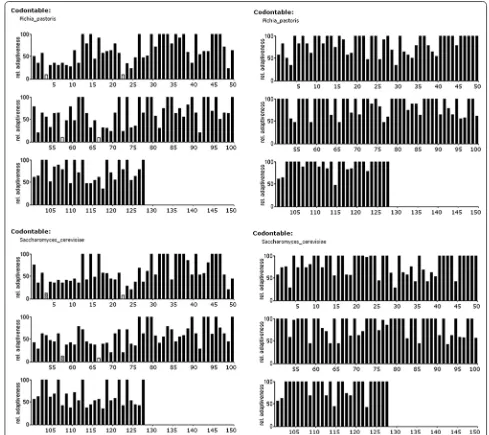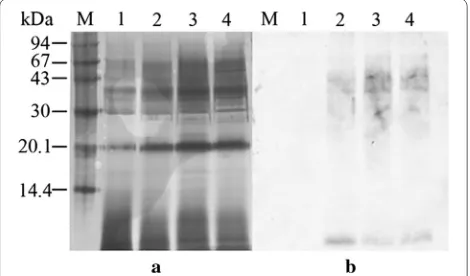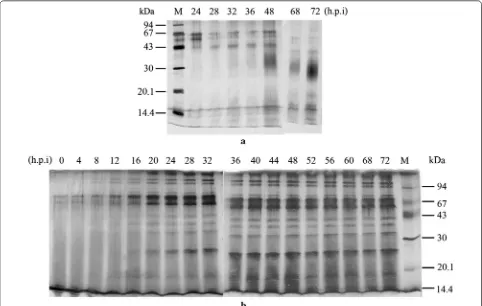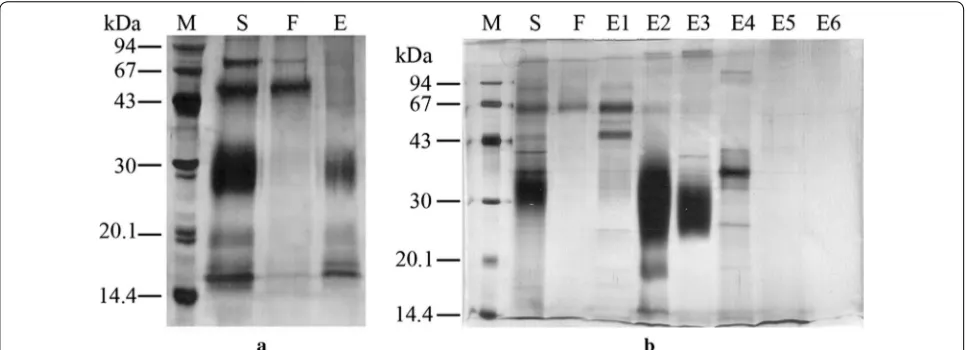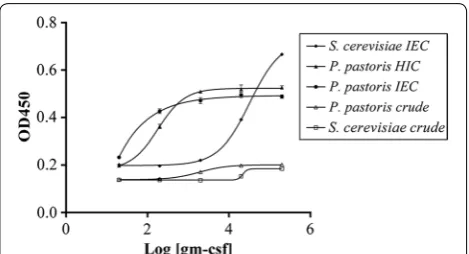RESEARCH ARTICLE
Pichia pastoris
versus
Saccharomyces
cerevisiae:
a case study on the recombinant
production of human granulocyte-macrophage
colony-stimulating factor
Anh‑Minh Tran
1†, Thanh‑Thao Nguyen
1†, Cong‑Thuan Nguyen
1, Xuan‑Mai Huynh‑Thi
1, Cao‑Tri Nguyen
1,
Minh‑Thuong Trinh
1, Linh‑Thuoc Tran
1, Stephanie P. Cartwright
2, Roslyn M. Bill
2and Hieu Tran‑Van
1*Abstract
Background: Recombinant human granulocyte‑macrophage colony‑stimulating factor (rhGM‑CSF) is a glycoprotein that has been approved by the FDA for the treatment of neutropenia and leukemia in combination with chemothera‑ pies. Recombinant hGM‑CSF is produced industrially using the baker’s yeast, Saccharomyces cerevisiae, by large‑scale fermentation. The methylotrophic yeast, Pichia pastoris, has emerged as an alternative host cell system due to its shorter and less immunogenic glycosylation pattern together with higher cell density growth and higher secreted protein yield than S. cerevisiae. In this study, we compared the pipeline from gene to recombinant protein in these two yeasts.
Results: Codon optimization in silico for both yeast species showed no difference in frequent codon usage. However, rhGM‑CSF expressed from S. cerevisiae BY4742 showed a significant discrepancy in molecular weight from those of P. pastoris X33. Analysis showed purified rhGM‑CSF species with molecular weights ranging from 30 to more than 60 kDa. Fed‑batch fermentation over 72 h showed that rhGM‑CSF was more highly secreted from P. pastoris than S. cerevisiae (285 and 64 mg total secreted protein/L, respectively). Ion exchange chromatography gave higher purity and recovery than hydrophobic interaction chromatography. Purified rhGM‑CSF from P. pastoris was 327 times more potent than rhGM‑CSF from S. cerevisiae in terms of proliferative stimulating capacity on the hGM‑CSF‑dependent cell line, TF‑1.
Conclusion: Our data support a view that the methylotrophic yeast P. pastoris is an effective recombinant host for heterologous rhGM‑CSF production.
Keywords: S. cerevisiae, P. pastoris, rhGM‑CSF, Fermentation, Bioactivity, TF‑1 cell
© The Author(s) 2017. This article is distributed under the terms of the Creative Commons Attribution 4.0 International License (http://creativecommons.org/licenses/by/4.0/), which permits unrestricted use, distribution, and reproduction in any medium, provided you give appropriate credit to the original author(s) and the source, provide a link to the Creative Commons license, and indicate if changes were made. The Creative Commons Public Domain Dedication waiver (http://creativecommons.org/ publicdomain/zero/1.0/) applies to the data made available in this article, unless otherwise stated.
Background
Human granulocyte-macrophage colony-stimulating factor (hGM-CSF), a glycosylated cytokine, plays a vital role in proliferation and differentiation of granulocytes and macrophages from bone marrow progenitor cells [1].
hGM-CSF also enhances cytotoxicity of macrophages and monocytes towards tumor cells [2], as well as tumor presentation of dendritic cells [1, 3]. Due to its stimula-tory capacity on hematopoietic stem cells, recombinant hGM-CSF (rhGM-CSF) is recommended for therapeu-tic use in combination with chemo- or radio-therapy for cancer or transplantation patients [4].
hGM-CSF comprises 127 amino acids. The pres-ence of 2 N- and 4 O-glycosylation sites leads to differ-ent glycoforms with molecular weights ranging from 14 to 60 kDa [3]. The glycosylation of the protein affects its
Open Access
*Correspondence: tvhieu@hcmus.edu.vn
†Anh‑Minh Tran and Thanh‑Thao Nguyen contributed equally to this work 1 Faculty of Biology and Biotechnology, University of Science, VNU‑HCM,
Ho Chi Minh, Vietnam
pharmacokinetics, in vivo half-life, immunogenicity and cytotoxicity [3].
rhGM-CSF is produced from bacteria, baker yeast or mammalian hosts [5]. rhGM-CSF produced in Escheri-chia coli is biologically active but unstable in human plasma. It induces an immune reaction because N-formyl methionine (fMet) is its first amino acid. rhGM-CSF pro-duced in mammalian hosts has a similar glycosylation pattern to the native human protein, but production rates are slow [6, 7]. The product from baker’s yeast, Saccha-romyces cerevisiae, is glycosylated and approved by the FDA for the treatment of neutropenia and leukemia in combination with chemo- or radio-therapy for cancer or transplantation patients. The drawbacks of using S. cer-evisiae are hyper-glycosylated products and low cell den-sity growth.
The methylotrophic yeast Pichia pastoris has emerged as an alternative host due to its shorter and less immu-nogenic glycans, higher density cell growth and higher secreted protein yields than S. cerevisiae. In this study, we show that P. pastoris secretes a higher yield of more active recombinant rhGM-CSF than S. cerevisiae.
Methods
In silico codon optimization
hGM-CSF coding sequences were from Gene Bank (Accession M11220). In silico codon optimization was done using DNA 2.0 software with P. pastoris and S. cer-evisiae codon tables and optimized parameters [8]. The optimization evaluation was done via http://www.gcua. schoedl.de with low (<20%) frequency codon usage dis-played as hatched bars and very low (<10%) frequency codon usage as white bars.
Expression of rhGM‑CSF in P. pastoris and S. cerevisiae
Recombinant P. pastoris and S. cerevisiae rhGM-CSF clones were expressed as described previously [9, 10]. The expression of the rhGM-CSF was analyzed by SDS-PAGE and immuno blot probed with an antibody against hGM-CSF (LifeSpan BioScience). Briefly, recombinant S. cerevisiae strain BY4742/hgm-csf was cultured in selec-tive CSM-ura medium (6.7 g/L yeast nitrogen base with ammonium sulphate, 0.1 M sodium phosphate, sup-plemented with amino acids lacking uracil [11]) supple-mented with 2% glucose until the OD600 of the culture was 0.5–1. The cells were then harvested and transferred into CSMG-ura medium (CSM supplemented with 20 g/L galactose) with shaking at 230 rpm at 30 °C. The pH 6.0 of each medium was stabilized by 0.1 M sodium phosphate buffer. The sample supernatants were col-lected after 72 h of induction and stored for further analysis.
Recombinant P. pastoris X33::hgm-csf was grown in 10 mL BMGY medium (2% peptone, 1% yeast extract, 0.34% yeast nitrogen base, 1% ammonium sulfate, 1% glycerol, and 0.4 mg/L biotin, buffered with 1/10 vol-ume of pH 6.0 potassium phosphate buffer) at 30°C with constant shaking at 250 rpm until the culture reached an OD600 of 2–4. The cells were harvested and re-suspended in 10 mL BMMY (0.5% methanol is substituted for 1% glycerol in BMGY) with the same growth conditions. For induction, methanol was added every 24 h to a final con-centration of 0.5%. After 72 h, culture supernatants were collected by centrifugation for further analysis.
Fermentation of recombinant P. pastoris and S. cerevisiae
Recombinant yeast S. cerevisiae strain BY4742/hgm
-csf was batch-cultured in selective CSM(-ura) medium, pH 5.0 supplemented with 2% glucose until the culture reached an OD600 of 0.5 to 1, and then transferred into 3.18 L YP medium to a final OD600 of 0.5 in a 5 L LiFlus-GX fermenting vessel system (Biotron). Others growth parameters were temperature at 30 °C, aeration rate 1.5 vvm (through a filter), and agitation speed 720 rpm. Every 24 h, 40 g/L galactose was added at a rate of 6.7 mL/h. Samples were harvested at every 4 h and analyzed. Growth of the yeast cultures was monitored by optical density measurements at 600 nm. Protein secretion in the fermented medium was analyzed by SDS-PAGE and the protein concentration was determined using Brad-ford’s method [12]. The supernatant was stored at −20 °C for later purification.
Ion exchange chromatography and hydrophobic interaction chromatography purification of recombinant rhGM‑CSF
rhGM-CSF was purified using hydrophobic interaction chromatography. A HiPrep Phenyl Fast Flow column was equilibrated in buffer A [(NH4)2SO4 2 M, CH3COONa 20 mM, pH 5.0]. Approximately 20 mL of filtered super-natant was loaded onto the column at 1 mL/min. The col-umn was then washed with 10 colcol-umn volumes of buffer B. The bound protein was subsequently eluted with buffer B (Na2HPO4 10.14 mM; KH2PO4 1.76 mM; NaCl
136.89 mM; KCl 2.68 mM, pH 7.4) in a step-wise manner, ranging from 5, 10, 20, 40, 60 and 100% buffer B. The tar-get fractions were identified by SDS-PAGE. The protein was eluted maximally at 10 to 20% buffer B.
rhGM-CSF was alternatively purified using anion exchange chromatography at pH 7.5. A HiTrap Q Sepha-rose Fast Flow column was equilibrated in 50 mM Tris-HCl. Approximately 20 mL of filtered and desalted supernatant was loaded onto the column at 1 mL/min. The column was then washed with 10 column volumes of 50 mM Tris-HCl. The bound protein was subsequently
[image:3.595.52.541.254.689.2]eluted in a step-wise manner with the NaCl concentra-tion optimized over a range of 0–1 M NaCl in 50 mM Tris-HCl. The target fractions were identified by SDS-PAGE. The protein was eluted maximally at 0.1–0.2 M NaCl.
Bioactivity of purified rhGM‑CSF
Purified rhGM-CSF from each yeast species was added to 1 × 105 cells/mL of TF-1 (a GM-CSF dependent cell line) in RPMI plus 10% FBS to obtain a final rhGM-CSF concentration ranging from 2 × 104 to 2 × 10−1 pg/mL. 100 µL of each combination was aliquoted into a 96-well plate and cultured for 72 h in a 5% CO2 incubator. The proliferation of TF-1 cells was measured by using a CCK-8 kit at OD 450 nm according to the manufacturer’s instructions. Crude supernatants from P. pastoris and S. cerevisiae served as controls. LU (Laboratory unit) was calculated as follows:
Results
In silico optimization removes low frequency codon usage in both yeasts
In contrast to the native human sequence, both in silico -optimized sequences show a high relative adaptiveness (Fig. 1, right column). These low (<20%, hatched bars) or very low (<10%, white bars) frequency codons were sub-stituted for higher frequency codons. The optimization step did not introduce restriction enzyme(s) to the opti-mized sequences (data not show) which facilitated the subsequent cloning steps.
Differences in the expression profile of rhGM‑CSF in the two yeast species
The expression profile of rhGM-CSF was analyzed using SDS-PAGE and probed with a specific antibody against hGM-CSF. The induction of P. pastoris with methanol led to the expression of several proteins (Fig. 2). Probing with a specific antibody showed the majority of the expressed rhGM-CSF ranged in size from 28–43 kDa with two minor bands at 17.8 and 24 kDa. In contrast, following induction of recombinant S. cerevisiae cells with galac-tose, there was no difference compared to control cells (Fig. 3). Probing with a specific antibody showed the majority of expressed rhGM-CSF ranged in size from 30 to 67 kDa.
Recombinant hGM‑CSF is highly secreted from P. pastoris
Time-course expression showed an accumulation of rhGM-CSF (Fig. 4). In the last 72 h, the secreted protein/ OD600 ratio was dramatically increased in P. pastoris. The cultures grew to a very high density of 134 OD units over
LU(units/mg)= 1×10
9
ED50
the time course compared to 32 OD units for S. cerevisiae
(Fig. 5). Consequently, this led to a higher total secreted protein yield per mL culture medium at 72 h post-induc-tion (285 mg for P. pastoris vs 64 mg for S. cerevisiae).
Ion exchange chromatography is more efficient in recovery of rhGM‑CSF than hydrophobic interaction chromatography
Recombinant hGM-CSF produced in P. pastoris was eluted maximally at 10–20% buffer phosphate. The purity was 85.2% and the recovery yield was 53.8% (Fig. 6
Fig. 2 The expression of rhGM‑CSF in P. pastoris analyzed by SDS‑ PAGE (a) and immunoblot probed with an anti‑hGM‑CSF antibody (b). M, molecular mass markers; 1, P. pastoris X33 culture supernatant 72 h post‑induction with methanol; 2, P. pastoris X33::hgm‑csfculture supernatant 72 h post‑induction; 50 µL crude supernatant was pre‑ cipitated and loaded per lane
[image:4.595.305.540.87.268.2] [image:4.595.305.540.512.650.2]and Table 1). In contrast, using ion exchange chroma-tography, rhGM-CSF was eluted with 10 and 20% elu-tion buffer; the purity ranged from 92 to 95%, and the recovery yield was 36–56% (Fig. 6 and Table 1). Collec-tively, ion exchange chromatography was more efficient in recovery of rhGM-CSF than hydrophobic interaction chromatography. A similar result was also obtained for rhGM-CSF produced in S. cerevisiae (data not shown and Table 1).
Recombinant hGM‑CSF produced from P. pastoris shows high bioactivity on a GM‑CSF‑dependent cell line
The purity of a sample strongly affects its bioactivity. Thus to precisely evaluate bioactivity, rhGM-CSF pro-duced from both yeasts was only tested with a purity above 80%. These samples were evaluated using a GM-CSF-dependent cell line, namely TF-1. The response curves showed a typical sigmoidal cytokine response. To compare the responses, effective dose 50 (ED50) (pg/mL) and laboratory unit (LU) (units/mg) were cal-culated from each curve as shown in Table 2. The ED50 of purified rhGM-CSF increased on going from protein
Fig. 4 The secreted expression of rhGM‑CSF analyzed by SDS‑PAGE; hours post induction (h.p.i) are indicated for P. pastoris X33::hgm‑csf induced with methanol (a) or S. cerevisiae BY4742/pYES2‑hgm‑csf induced with galactose (b). M molecular mass markers; 50 µL crude supernatant was precipitated and loaded per lane
[image:5.595.57.539.88.394.2] [image:5.595.307.539.466.645.2]produced using P. pastoris and IEC, P. pastoris and HIC,
S. cerevisiae and IEC to S. cerevisiae and HIC. Nota-bly, purified rhGM-CSF from P. pastoris using IEC had higher purity than protein from P. pastoris using HIC (Fig. 7).
Discussion
Four publications describe rhGM-CSF expression in three different yeast systems, including the well-known yeasts S. cerevisiae, P. pastoris and Yarrowia lipolytica
[14–17], but none conducts a head-to-head comparison. In the present study, we used an in silico-optimized syn-thetic hGM-CSF gene in two yeast expression vectors.
The expression patterns were similar to those previously published [14, 15, 17].
Using fed-batch fermentation, we obtained yields of rhGM-CSF of 9.5 and 180.3 mg/L from S. cerevisiae
and P. pastoris respectively. The latter is higher than has been previously described [17], possibly because we used single-copy rather than high-copy integration. All published protocols on the purification of rhGM-CSF combine two different purification steps to get above 95% purity [14–17]. In our study, we used a one-step procedure to obtain greater than 95% purity.
The activity of purified rhGM-CSF from S. cerevisiae on TF-1 cells was 0.36 × 105 LU/mg, which is lower than that of the commercially available drug Leukine (rhGM-CSF). Table 1 Purification yield of rhGM-CSF from P. pastoris and S. cerevisiae using IEC with % elution buffer or HIC
Sample GM‑CSF from P.
pastoris (IEC) 10% GM‑CSF from pastoris (IEC) 20%P. GM‑CSF from pastoris (HIC)P. GM‑CSF from cerevisiae (IEC) S. 10%
GM‑CSF from S. cerevisiae (IEC) 20%
GM‑CSF from S. cerevisiae (HIC)
Purity (%) 92.7 95.2 85.2 95.6 64.22 42.9
Purification yield (%) 56.9 35.9 53.8 21.0 30.8 0.5
Fig. 6 Purification of rhGM‑CSF from culture supernatants of P. pastoris X33::hgm‑csf induced with methanol analyzed by SDS‑PAGE. a Hydropho‑ bic interaction chromatography. M molecular mass markers, S supernatant after 72 h, F column flow‑through, E eluted fraction. b Ion exchange chromatography. M molecular mass markers, S supernatant after 72 h, F column flow‑through, E1–6 fractions eluted with NaCl (50, 100, 200, 400, 600 and 1000 mM, respectively)
Table 2 Bioactivity of purified rhGM-CSF from P. pastoris and S. cerevisiae using IEC or HIC
ED50 (pg/mL) LU (units/mg) Response curve range (OD unit)
GM‑CSF from P. pastoris (IEC) 84.5 11.8 × 106 0.26
GM‑CSF from P. pastoris (HIC) 198.7 5.0 × 106 0.32
GM‑CSF from P. pastoris (crude) 1876 0.53 × 106 0.06
GM‑CSF from S. cerevisiae (IEC) 27,880 0.36 × 105 0.49
[image:6.595.57.541.103.166.2] [image:6.595.55.540.202.293.2] [image:6.595.57.540.502.677.2]The discrepancy could be due to the glycosylation moiety added to rhGM-CSF [3] which in turn could have an effect on its bioactivity. The drug Leukine contains a non-glyco-sylated rhGM-CSF in contrast to our purified, glyconon-glyco-sylated rhGM-CSF. Purified rhGM-CSF from P. pastoris had an activity of 1.2x107 LU/mg. This activity is almost equal to the standard sample announced by WHO [18] and is two times higher than that of Leukine. Compared to previous data [17], our purified rhGM-CSF is 15 times less active. When compared with our E. coli-derived rhGM-CSF (non-glycosylated), our data show that rhGM-CSF is 1.5 times lower than that of E. coli origin (unpublished data). With the same purity, rhGM–CSF from S. cerevisiae was 327 times less active than that from P. pastoris.
Conclusion
In this study, we have been able to compare the pipeline from gene to recombinant protein between S. cerevi-siae and P. pastoris. Our results suggest that rhGM-CSF expressed in P. pastoris is more active than the same pro-tein from S. cerevisiae. To our knowledge, the data pre-sented here are the first head-to-head comparison of S. cerevisiae and P. pastoris as host cells for rhGM–CSF production.
Abbreviations
rhGM‑CSF: recombinant human granulocyte‑macrophage colony‑stimulating factor; FDA: Food and Drug Administration; TF‑1: human erythroleukemic cell Additional files
Additional file 1. Results of fed‑batch fermentation process of P. pastoris X33::hgmcsf and S. cerevisiae BY4742/pYES2‑hgmcsf.
Additional file 2. Results of bioactivity analysis of purified hGM‑ CSF derived from P. pastoris X33::hgmcsf and S. cerevisiae BY4742/ pYES2‑hgmcsf.
line; SDS‑PAGE: sodium dodecyl sulfate‑polyacrylamide gel electrophoresis; OD: optical density; LU: laboratory unit; ED50: effective dose 50; IEC: ion exchange chromatography; HIC: hydrophobic interaction chromatography; WHO: World Health Organization.
Authors’ contributions
AMT and TTN initiated the study, prepared the recombinant clones and participated in the data analysis and interpretation. TCN and MTT carried out the fermentations. XMH performed the expression analysis. AMT and CTN performed the purification. TTN and HTV conducted bioassay evaluation. TLT participated in the experimental design. SC and RB participated in the experi‑ mental design and helped to draft the manuscript. HTV participated in the study design, coordinated the data analysis and interpretation, and drafted the manuscript. All authors contributed to the final version of the manuscript. All authors read and approved the final manuscript.
Author details
1 Faculty of Biology and Biotechnology, University of Science, VNU‑HCM, Ho
Chi Minh, Vietnam. 2 School of Life and Health Sciences, Aston University,
Birmingham, UK.
Acknowledgements
We thank Prof. Toshio Kitamura, Institute of Medical Science, University of Tokyo for providing the TF‑1 cell line.
Competing interests
The authors declare that they no competing interests.
Availability of supporting data and materials
Underlying data is contained in Additional files 1 and 2. This data has also been deposited at Figshare: https://figshare.com/articles/Data_of_ Fig_5/4762642 and https://figshare.com/articles/Data_of_Fig_7/4762636.
Funding
Research funding was from the Science and Technology Research Program through the Department of Science and Technology Hochiminh City (Grant Number: 77/2013/HĐ‑SKHCN). The British Council supported a visit of HTV to Aston University. The funding bodies have no role in the design, collection, analysis, interpretation and reporting of data or in writing the manuscript.
Publisher’s Note
Springer Nature remains neutral with regard to jurisdictional claims in pub‑ lished maps and institutional affiliations.
Received: 30 September 2016 Accepted: 27 March 2017
References
1. Metcalf D. The granulocyte‑macrophage colony‑stimulating factors. Sci‑ ence. 1985;229(4708):16–22.
2. Grabstein KH, Urdal DL, Tushinski RJ, Mochizuki DY, Price VL, Cantrell MA, Gillis S, Conlon PJ. Induction of macrophage tumoricidal activ‑ ity by granulocyte‑macrophage colony‑stimulating factor. Science. 1986;232(4749):506–8.
3. Ghosh PK, Bhardwaj D, Karnik R. Human granulocyte‑macrophage colony‑stimulating factor: the protein and its current & emerging applica‑ tions. Indian J Biotechnol. 2007;6(4):435–41.
4. Nicola AN. GM‑CSF. In: Oppenheim JJ, Feldmann M, Durum SK, editors. Cytokine reference: a compendium of cytokines and other mediators of host defense, vol. 1. 1st ed. New York: Academic Press; 2001. p. 900–5. 5. Dorr RT. Clinical properties of yeast‑derived versus Escherichia coli‑
derived granulocyte‑macrophage colony‑stimulating factor. Clin Ther. 1993;15(1):19–29.
6. Armitage JO. Emerging applications of recombinant human granulocyte‑ macrophage colony‑stimulating factor. Blood. 1998;92(12):4491–508. 7. Bollati‑Fogolin M, Forno G, Nimtz M, Conradt HS, Etcheverrigaray M,
Kratje R. Temperature reduction in cultures of hGM‑CSF‑expressing
[image:7.595.57.292.87.214.2]• We accept pre-submission inquiries
• Our selector tool helps you to find the most relevant journal
• We provide round the clock customer support
• Convenient online submission
• Thorough peer review
• Inclusion in PubMed and all major indexing services
• Maximum visibility for your research
Submit your manuscript at www.biomedcentral.com/submit
Submit your next manuscript to BioMed Central
and we will help you at every step:
CHO cells: effect on productivity and product quality. Biotechnol Prog. 2005;21(1):17–21.
8. Villalobos A, Ness JE, Gustafsson C, Minshull J, Govindarajan S. Gene Designer: a synthetic biology tool for constructing artificial DNA seg‑ ments. BMC Bioinform. 2006;7:285–92.
9. Lien PTK, Truong DT, Hieu TV. Cloning and expression of human granulo‑ cyte‑macrophage colony stimulating factor (hGM‑CSF) in Pichia pastoris. J Sci Technol Dev. 2013;16(3):13–21.
10. Minh TA, Thao NT, Cartwright SP, Bill RM, Hieu TV. Cloning, expression and isolation of recombinant protein hGM‑CSF in Saccharomyces cerevisiae. J Biotechnol. 2015;13(2A):643–9.
11. Darby RAJ, Cartwright SP, Dilworth MV, Bill RM. Which yeast species shall I choose? Saccharomyces cerevisiae versus Pichia pastoris (review). In: Bill RM, editor. Recombinant protein production in yeast—methods and protocols. Berlin: Springer Science; 2012. p. 14.
12. Bradford MM. A rapid and sensitive method for the quantitation of micro‑ gram quantities of protein utilizing the principle of protein‑dye binding. Anal Biochem. 1976;72:248–54.
13. Invitrogen. Pichia fermentation process guidelines. Carlsbad: Invitrogen Corporation; 2002.
14. Miyajima A, Otsu K, Schreurs J, Bond MW, Abrams JS, Arai K. Expression of murine and human granulocyte‑macrophage colony‑stimulating factors in S. cerevisiae: mutagenesis of the potential glycosylation sites. EMBO J. 1986;5(6):1193–7.
15. Bhatacharya P, Pandey G, Mukherjee KJ. Production and purification of recombinant human granulocyte‑macrophage colony stimulating factor (GM‑CSF) from high cell density cultures of Pichia pastoris. Bioprocess Biosyst Eng. 2007;30(5):305–12.
16. Gasmi N, Lassoued R, Ayed A, Tréton B, Chevret D, Nicaud JM, Kallel H. Production and characterization of human granulocyte–macrophage colony‑stimulating factor (hGM‑CSF) expressed in the oleaginous yeast Yarrowia lipolytica. Appl Microbiol Biotechnol. 2012;96(1):89–101. 17. Srinivasa Babu K, Pulicherla KK, Antony A, Meenakshisundaram S. Clon‑
ing and expression of recombinant human GMCSF from Pichia pastoris GS115‑A progressive strategy for economic production. Am J Ther. 2014;21(6):462–9.
